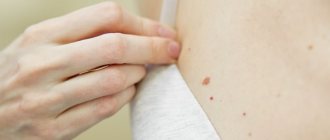When you hear the word “urticaria”, you immediately imagine redness of the skin, a rash and an unpleasant itching - you just want to scratch!.. Indeed, this disease (or rather, a whole group of diseases) has its name for a reason. Its manifestations are very similar to the consequences of a nettle “bite”.
Blisters and redness can be localized on various parts of the body - face, arms, legs, back, neck, etc., and after disappearing they do not leave any trace.
Urticaria can occur suddenly in any person (according to statistics, from 10 to 35% of the world's population suffer from it at least once in their lives), but should you be afraid of it? What are its causes and how to treat this disease? Is it dangerous? Let's figure it out.
“Oh, I’m blushing all over!..” But why?
Urticaria, or nettle fever, is an allergic disease. Hives can be either a direct reaction to an allergen or one of the manifestations of a wide range of diseases of a very different nature.
Hives are not contagious, and therefore you should not be afraid of people who are “showered” with red blisters.
However, there is one “but”... Often, urticaria occurs together with Quincke’s edema, which is its most dangerous feature.
The fact is that this swelling can spread to the mucous membrane of the larynx, which without urgent medical help can lead to respiratory arrest and death. Urticaria is divided into acute and chronic.
Acute nettle fever
It occurs suddenly and does not last long - from several hours to a couple of weeks. Acute urticaria can be caused by allergies to insect bites, food, or an infection that has affected the human body. This form of the disease is most common in children.
Causes of acute urticaria include allergic reactions to:
- food products (the most common cause of the disease);
- medications;
- insect bites (especially bees and wasps);
- weather and physical conditions (cold, heat, sun rays, vibration, pressure changes, etc.);
- other substances and materials that can act as an allergen (latex, animal saliva).
Infectious diseases can also cause acute urticaria.
Experts note that sometimes acute nettle fever becomes chronic, which requires longer and more complex treatment.
Chronic urticaria
As its name suggests, it lasts a long time. It can be observed for several months. The causes of this type of illness are more serious. These include disturbances in the functioning of various organs - the liver, kidneys, gastrointestinal tract, chronic infections, and toxicosis of pregnant women. Doctors say that chronic urticaria is an autoimmune pathology (this is the name for the phenomenon when the body mistakes its own cells for foreign ones and begins to fight them). It affects mostly adults, and women are especially susceptible to it.
However, a significant proportion of chronic urticaria does not have a clearly identified cause. In other words, this pathology has not yet revealed all its secrets, and therefore its danger, expressed in the likelihood of developing Quincke's edema and anaphylactic shock, has not decreased to this day.
Hives during pregnancy
Pregnant women suffer from hives quite often. This is due to changes in hormonal levels and decreased immunity. During pregnancy, the level of estrogen increases, which can be an impetus for the development of the disease.
Signs of urticaria:
- characteristic rashes (blisters);
- itching accompanied by scratching;
- insomnia and irritability.
Urticaria does not directly affect the fetus, but it annoys the woman and makes her nervous. In addition, complications or a chronic form may occur.
Urticaria and its treatment: you can’t do without a doctor!
Let us remind you that, although urticaria itself is safe and goes away without a trace, the “companion” of this disease - Quincke's edema - can lead to serious consequences.
That is why you should pay utmost attention to the first signs of nettle fever and consult a doctor who will determine the causes of the disease and give the necessary recommendations. This is especially important if the rash appears in children.
If symptoms of anaphylactic shock appear (difficulty breathing and swallowing, in women - spasms and pain in the uterine area), you must immediately call an ambulance.
To determine the nature of the pathology, an allergist-immunologist will examine the patient and conduct the necessary tests and tests for allergens.
Having made conclusions about the causes of urticaria, the doctor will begin treatment. Patients with acute urticaria are prescribed antihistamines, and patients suffering from chronic urticaria also take immunomodulators.
It is important to remember that the treatment process will be quite long, but it will be most effective if you follow the correct lifestyle: you need to remove everything that can cause an allergic reaction, adhere to the diet recommended by your doctor, stop smoking and drinking alcohol.
Never take antihistamines unless prescribed by a specialist. By doing this you can only harm yourself and your body.
Causes of urticaria in pregnant women
The reasons for the development of urticaria in pregnant women are the same as in other patients. Most often, an allergic form occurs when the allergens are foods, chemicals, or poison from insect bites. Urticaria can also be a consequence of:
- liver pathologies;
- autoimmune inflammation (rejection of one’s own tissues);
- the presence of parasites: worms, lamblia;
- diseases of the endocrine system;
- women's diseases;
- other internal diseases.
If signs of urticaria appear, you should immediately contact a venereodermatologist or an allergist. Once the diagnosis is confirmed, consultation with other specialists may be necessary.
Quality of life of patients with chronic urticaria
In one clinical study, patients with chronic urticaria were asked: what is the worst symptom of your disease [17]? Most patients gave more than one answer to the question, of which 59% noted swelling as the worst symptom of urticaria, 42% itching, and 22% pain. In addition, 22% of patients noted symptoms of the disease such as feeling tired, irritable, weak, or feeling out of control over their lives. In 20% of cases, patients were very concerned about the unpredictability of the development of the next exacerbation of urticaria, in 18% of cases, problems for patients were social restrictions, in 13% - a feeling of awkwardness, in 7% - difficulties in doing work, in 7% - restrictions on eating or wearing clothes , in 5% - unwanted side effects of medications, in 3.6% - the inability to relax and rest.
Patients with chronic urticaria experience a wide range of negative emotions. Thus, most of them suffer from nonspecific anxiety and are afraid that their urticaria is caused by another, more serious disease. In addition to anxiety, people with urticaria suffer from anger and depression. It is difficult for them to cope with emotions, due to the fact that they were unable to properly identify, express and convey their feelings, i.e. suffered from alexithymia [18]. Moreover, the severity of these symptoms directly correlates with the severity of itching.
It should also be noted that patients with chronic urticaria often suffer from concomitant psychiatric pathology - comorbid mental illnesses were identified in 34.5% of patients with urticaria: in the general population - 25%, among patients with psoriasis - 26% [18]. Most often, patients with chronic urticaria had concomitant anxiety (30%), as well as depressive (17%) and somatoform (17%) disorders. Agoraphobia is the most common (15%) manifestation of anxiety [19].
Intrahepatic cholestasis of pregnancy
Definition.
Intrahepatic cholestasis of pregnancy (ICP, intrahepatic cholestasis syndrome of pregnancy, obstetric cholestasis, idiopathic jaundice of pregnant women) is one of the specific dermatoses of pregnancy (IDP), which is characterized by an increase in the level of aminotransferases and bile acids (≥10 μmol/l) in the blood serum, the development of intense itching (this intensity is not typical for other SDB) at the end of pregnancy (in 80% of patients - in the II-III trimester), mainly secondary damage to the skin (excoriations occur, etc.), spontaneous and rapid (from 2 days to 3 weeks ) regression of clinical symptoms after childbirth and, finally, not always a favorable outcome for the fetus [1-5].
In 1883, the disease was first described by F. Alfeld [6].
Epidemiology.
ICP is a relatively common cause of liver problems during pregnancy. In Central and Western Europe and North America, the incidence of ICP is 0.4-1.0%, in the Scandinavian and Baltic countries - up to 3%, and in Chile and Bolivia 5-28% (this may be due to the gastronomic preferences of local residents) [7, 8]. Unlike polymorphic rash of pregnancy (EPP), ICP recurs during subsequent pregnancies [1, 8].
ICP is more often observed in the cold season [7].
Etiopathogenesis.
A genetic predisposition to the development of ICP is evidenced by a family history (in 50% of patients), ethnic and geographical differences, the presence of histocompatibility antigens HLA-A31 and HLA-B8 (positive correlation), mutations of the ABC-B4 genes on the 7th chromosome (encodes MDR-3 protein; disruption of the activity of transport proteins, phospholipids, bile formation, etc.), ABC-B11 on the 2nd chromosome (encodes the BSEP protein; changes in the so-called bile salt export pump), ATP-8-B1 on the 18th chromosome (encodes the FIC1 protein; insignificant role) [4, 9–11, 33].
The role of endocrine factors deserves attention. ICP is most often observed in the last trimester of pregnancy (estrogens concentration reaches a maximum), in twin or triple pregnancies (estrogens concentration is higher than in singleton pregnancies), as well as in persons who took hormonal (estrogenic) contraceptives before pregnancy (ICP in in the appropriate context, is considered as a hyperergic response of the body to increased estrogen levels). Subsequently, the cholestatic effects of sex hormones and their metabolites develop. We must also not forget about the role of progesterone (hyperprogesteronemia), selenium (a decrease in selenium concentration leads to cholestasis, and vice versa) and others [1, 4, 12, 13].
Under the influence of the above factors, the content of bile acids in the blood serum of pregnant women increases, they enter the blood of the fetus (pregnant women experience severe itching, uteroplacental blood flow is disrupted - acute oxygen deficiency develops, fetal cardiac activity is inhibited, etc.).
Clinic.
The main symptom of ICP is severe itching of the palms and soles, which usually occurs without any warning signs after 30 weeks of pregnancy, rapidly progresses and becomes unbearable, having a strong psychotraumatic effect and leading to the development of various nosogenies (for example, insomnia, depressive reactions, suicidal behavior) [4, 14].
Over time, the itching spreads to other areas (extensor surfaces of the limbs, buttocks, abdomen) and covers the entire body. It sometimes weakens, but then intensifies and becomes continuous and unbearable, continuing until the end of pregnancy. Usually, the itching disappears immediately after childbirth.
Itching is not caused by a primary skin lesion - it is affected secondarily (excoriation, erythematous-papular elements occur, and the itching worsens) [7].
Only in 10-20% of patients, a few weeks after the onset of the disease, jaundice develops in parallel with itching (sometimes preceding the appearance of itching), but the condition of the patients does not change much because of this, since the bilirubin level does not increase more than 100 μmol/L (not a critical value : complications such as bilirubin encephalopathy and so on do not occur) [14-16].
Sometimes observed malabsorption syndrome and steatorrhea (the result of impaired processes of breakdown and utilization of fats) lead to impaired absorption of various nutrients in the small intestine, for example fat-soluble vitamin K (necessary for the synthesis of prothrombin complex factors), which in turn leads to an increase in prothrombin time (hypocoagulation , intrauterine and postpartum hemorrhage) [1, 14, 17, 18].
Subsequently, women who have had ICP during pregnancy have an increased risk of developing hepatobiliary pathology (for example, cholelithiasis, cholecystitis) [19].
During subsequent pregnancies or when using hormonal contraceptives, the process recurs.
Laboratory diagnostics
.
The most sensitive biochemical indicators
for diagnosing ICP are an increase in the level of bile acids (more than 10-100 times) and aminotransferase activity (2-10 times) in the blood serum [1, 15, 20, 21]. However, it should be taken into account that the level of bile acids in healthy pregnant women at the end of pregnancy somehow increases, exceeding the normal limits (0-6 μmol/l), but not more than 2 times, which is not correctly attributed to pathology (asymptomatic hypercholanemia) [ 1, 22-24].
Pathohistological
changes in ICP are not specific.
The results of immunomorphological
research methods (direct and indirect immunofluorescence reactions) for ICP are negative.
Treatment.
The goal of drug treatment for ICP is to improve the mother’s condition (eliminate itching by reducing the level of bile acids in the blood serum, carry the pregnancy to term, improve the quality of life, etc.) and reduce the risk of developing pathology in the fetus (improving the medical prognosis of the fetus’s health). In this context, ursodeoxycholic acid (USCA, Ursofalk) is the most effective drug (antihistamines, sleeping pills, hormonal and other drugs are less effective). Often they also resort to induction of labor (during the 37-38th week of pregnancy, since stillbirths are often observed precisely at these dates or later) [1, 4, 15, 25-31].
Course and prognosis.
ICP in the DBS group is considered a disease that poses the maximum, although controllable, danger to both the mother and the fetus. However, for ICP, what is considered more important is not the mother’s itching, the possibility of intrauterine and postpartum hemorrhage (especially with jaundice and/or vitamin K deficiency), but possible complications in the fetus. With ICP, premature birth (19-60%), intrauterine hypoxia (22-41%), bradycardia (14%), stillbirth (0.4-4.1%), etc. are very often observed. The likelihood of these complications increases, especially when the concentration of bile acids in the mother’s blood serum exceeds 40 μmol/l [1, 4, 5, 20].
Both in the blood serum of patients with ICP, and in the umbilical cord blood and in the amniotic fluid of the fetus, the concentration of total bile acids can be very high, which leads to pathological changes in the surfactant of the fetal lung tissue with corresponding consequences [32].
There is also a positive correlation between high levels of total bile acids in the blood serum of maternal and newborn rats, the possibility of developing pathological changes in the lungs and a greater risk of stillbirth (experimental dermatology) [3].
Thus, early diagnosis of ICP, prescription of specific treatment and constant obstetric and gynecological monitoring are important for the correct choice of medical tactics and strategies in the management of patients.
Atopic rash of pregnancy
Definition.
Atopic rash of pregnancy (ASB, prurigo of pregnancy, pruritic folliculitis of pregnancy, eczema of pregnancy) is a benign, most common (in 50% of patients) RAS, which occurs in the first months of pregnancy (in 75% of cases - in the first trimester) in persons with predisposition to atopy, manifested by vesicular or papular elements. ASP usually recurs during subsequent pregnancies [34, 35].
Pathogenesis.
Currently, in the pathogenesis of ASP, the dominant version is a violation of the ratio and imbalance between Th1 and Th2 lymphocytes, as a result of which the production of Th1 cytokines (IL-2, γ-interferon, IL-12) is inhibited, and Th2 cytokines (IL-12) are inhibited. 4, IL-10), on the contrary, is stimulated [36].
Clinic.
ASD is divided into two types - intrinsing (internal, IgE-non-associated, non-allergic, atopiform dermatitis) and extrinsing (external, IgE-associated, allergic), but the issue of such a division is disputed [37].
In 80% of patients, ARS first occurs during pregnancy (only in this case the rash is classified as ARS). In 20% of patients, existing atopic dermatitis worsens (perhaps the disease has been in remission since childhood).
The process in 65-70% of cases manifests itself in the form of diffuse eczema (the so-called IgE-associated type of ASD), located in the favorite places of atopic dermatitis (face, neck, décolleté, flexor surfaces of the limbs), and in 30-35% of cases small erythematous (on the body and limbs) and lichenoid (on the legs and palms) papules [38]. Other characteristic stigmas of atopic dermatitis (severe dry skin, dermographism of the palms, follicular keratosis, lichen alba, and so on) are also often found [4, 35, 37, 39].
Laboratory diagnostics.
Pathohistological changes in ICP are not specific.
The results of immunomorphological
research methods (direct and indirect immunofluorescence reactions) for ASP are negative. A high concentration of IgE is detected in the blood of 20-70% of patients [34].
Treatment.
Local moisturizers (containing 3-10% urea) and antipruritic drugs (menthol, polidocanol and others) are often used. To prevent additional skin dryness, you can use mild, non-alkaline synthetic cleansers (skin lipid replacements), oil shower solutions, etc.
Local corticosteroid drugs are very effective. Moderately active corticosteroids are applied to the skin of the face and folds, and “strong” corticosteroids are applied to the rest of the body (extra-strength corticosteroids should be avoided) [40-42].
In severe cases, systemic non-halogen corticosteroid drugs are prescribed. Due to the fact that cortisol, prednisone and prednisolone are deactivated in the placenta (unlike betamethasone and dexamethasone), prednisolone is considered the drug of choice during pregnancy. The dosage depends on the nature of the pregnancy and the severity of ASP. The initial dose of prednisolone is 0.5-2 mg/kg/day (if necessary, the dose is increased, but in the first trimester of pregnancy it should not exceed 10-15 mg/day, since the likelihood of the child developing a cleft lip and cleft palate increases) [ 40-42].
To avoid side effects, the duration of corticosteroid therapy should not exceed 1 month. If the course is prolonged, then fetal growth must be monitored using ultrasound and not forgetting about the possibility of adrenal insufficiency developing in the newborn.
Antihistamines are also prescribed (preferably only in the first trimester of pregnancy) of both the first (dimetindene, clemastine, pheniramine, etc.; extensive experience with use) and second generation (loratadine, cetirizine, etc.; no pronounced sedative effect), phototherapy (UVB -therapy in difficult cases in early pregnancy is an additional, safe and effective tool), etc. [41, 42].
Course and prognosis.
The prognosis for ASP in the mother is favorable, but the disease can recur again during subsequent pregnancies.
The health of the fetus is also out of the danger zone, although in the future children may experience signs of atopic dermatitis.









